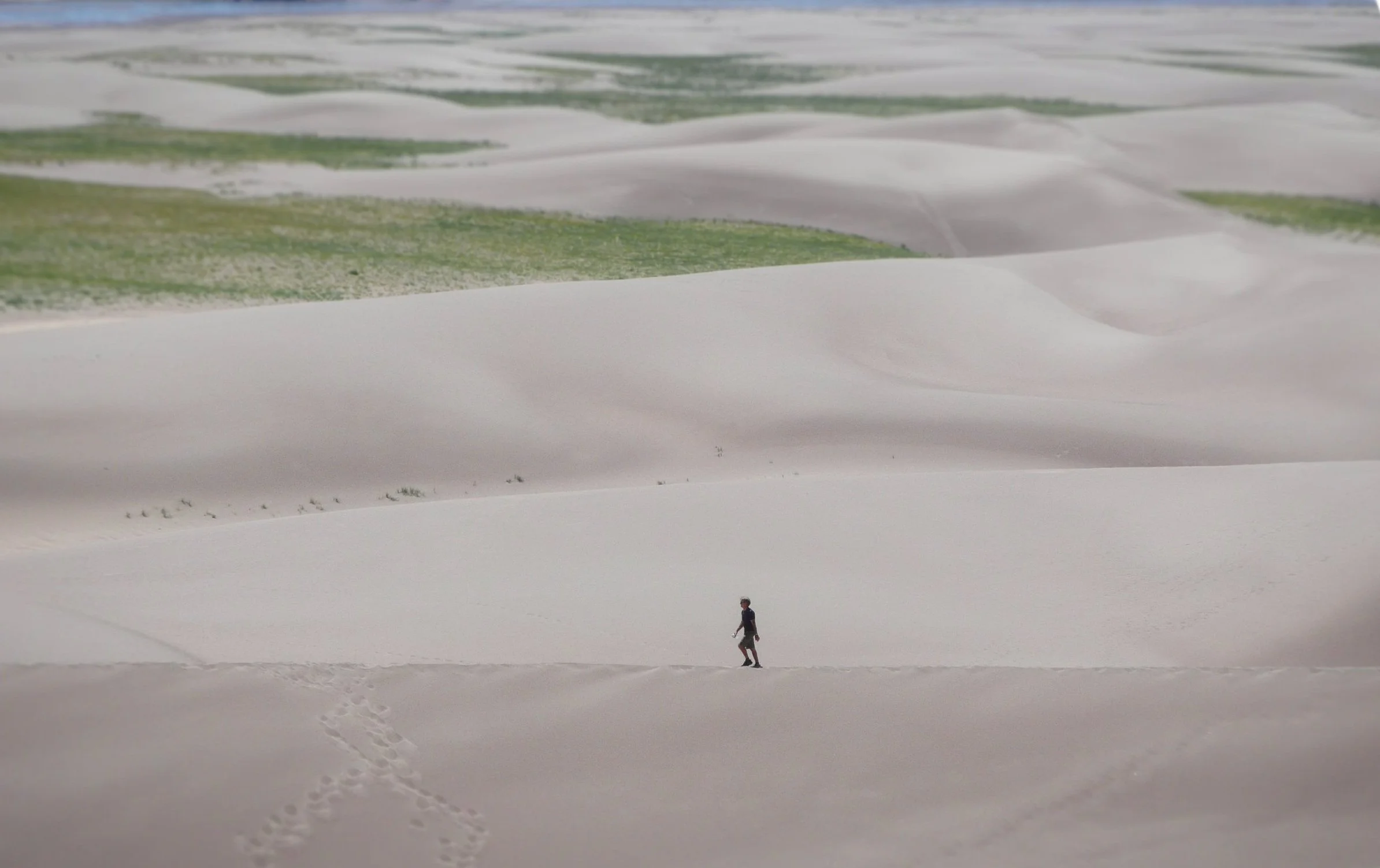Great Adventure in Great Sand Dunes NP
Sledding and boarding North America's tallest sand dunes
Photos by Michael Mundt
Driving from Alamosa—in the San Luis Valley of south-central Colorado—toward Great Sand Dunes National Park and Preserve, I can see what looks from a distance like an insignificant pool of dirt at the base of massive peaks.
And still as we drive closer, I can’t comprehend the Park’s enormity, diminished as it is in the shadows of the 13,000-feet Sangre de Cristo Mountains. That is, until we actually begin climbing the dunes. With sand boards and sand sled in hand, we opt for the highest point that still allows maximum downhill speed while trying to minimize our boys’ complaints. The problem is, no matter how far you hike into the dunes—recognized as the tallest in North America, with Star Dune boasting 750 feet from base to crest—your kids are bound to protest.
“Daaaaad! This is haaard!” “Ouch! This sand is too hot!” “But I don’t want to carry the board!” “How much fartheeeeeerrrrr?!”
In their defense, I was stifling my own objections. “Michael, WHY are we the only parents dragging kids this high?” “How can THIS MUCH sand get into my tennis shoes?” “Geez, these boards feel heavy.” “How much fartheeeeeerrrrr?!”
Complaining aside, I’m proud we completed our goal to board and sled
these undulating hills of endless sand, the creation of which scientists still dispute. Some believe they are the result of sand deposits from the great Rio Grande River that winds through the Valley; others think they are remnants of volcanic eruptions.
Regardless, there’s no question that the dunes are 30 square miles of magnificence, comprising about 10 billion cubic meters’ worth of sand. Or, as my “enginerd” husband estimates, “roughly enough sand to cover the entire state of Colorado in more than an inch of sand.”
I should have just asked my Uncle Brett first. “I’ll save you a trip,” he offered. “There’s lots and lots of sand there.” "Not anymore," I responded. “It’s all in our ears and teeth.” In other words, if you plan to board or sled these dunes, don’t be fooled. That sand is much less forgiving than snow. And you must prepare to get very dirty.
As I begin my first sled descent with hubris only a native Coloradoan can muster, I quickly bear down my feet on either side of the wooden projectile in a dismal effort to slow it down. Which only generates a piercing shower of sand in my eyes, mouth and neck.
“You were going fast!” Michael said once I’d labored back to my starting point. “I kept thinking, ‘Gee. I hope she doesn’t wreck!’”
Fortunately, the kids and husband fare much better than I, perfecting their boarding abilities enough that by the time we near the dunes’ base, other families are ooohing and aaahing at their proficiency. “See?” Michael says as we return to the car, grubby and spent. “I actually didn’t do such a bad job figuring out what to do.”
Uh huh. Next time I’m bringing snowshoes. (I’ve read they work on sand.) Or better yet, just a swimsuit so I can splash in Medano Creek—which lies seasonally at the base of the dunes—and watch everyone else, literally, bite the dust.
Sand Dunes Do’s and Don’ts
1. If you’re a parent of toddlers or younger, DO allow them to simply rollick in Medano Creek—a stream fed by snow runoff that flows along the base of the dunes through spring and summer—instead of plodding up what feels like mountains of quicksand. But if you insist, DON’T walk farther than the small hills at the base, where families tend to congregate. You’ll get plenty of sightseeing there with fewer objections from the kiddos.
2. If your children are game, DO allow them to attempt boarding or sledding the dunes with products designed specifically for the task (which also require special wax). DON’T bring traditional snow sleds like plastic saucers because they won’t work, at least from what I witnessed. In fact, I lent my sled to a couple of kids I saw marooned pathetically on their winter sleds, just so they could experience the thrill of sledding in sand. (See rental options below.)
3. DO wear socks/shoes, at the very least. At its peak, the sand can reach 150 degrees Fahrenheit, and I cannot emphasize enough how uncomfortable it feels in your shoes. Next time I visit, I will try wearing hiking boots, long socks and snowshoes. As well, I would sport a dew rag or scarf around my face, both for protection against inevitable wind gusts and sledding/boarding spills. Oh, and DON'T forget sunscreen!
RESOURCES
If your family wants to sled or board during your visit, you should reserve gear ahead of time. Here are two options:
-
Our vendor of choice (near the hotel), we rented one junior board, one adult board and one sled (perfect for one adult and one kid to ride simultaneously). Great selection of outdoor-recreation gear and clothing, and knowledgeable, helpful staff. The store also offers year-round rentals. Visit their site here or call 719.589.9759.
-
Located in the Great Sand Dunes Oasis, just outside the Park’s entrance. Offers limited sled/boards from April through October. Visit site here or call 719.378.2222.
-
We stayed one night at Comfort Inn & Suites in Alamosa, Colo., because of its proximity to the Park (about 35 miles). Clean, comfortable and modern, the free breakfast was underwhelming (as parents should expect from most family-friendly hotels). But the employees were welcoming and accommodating, and the hotel allowed easy access to our end goal. I would stay there again on future visits.
For more information on the Great Sand Dunes NP and Preserve, click here.




